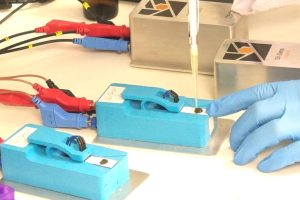
The effect is known as ‘stochastic resonance’, where mixing of noise and signal in the system non-linearity can sometimes push a previously buried signal just above the noise floor.
Now researchers at Penn State University have exploited it to improve the sensitivity of a custom FET light sensor based on the two-dimensional material molybdenum disulfide – a direct bandgap semiconductor with high quantum yield – and also the sensitivity of a commercial silicon photo-diode.
“Stochastic resonance is a phenomenon where a weak signal which is below the detection threshold of a sensor can be detected in the presence of a finite and appropriate amount of noise,” said Penn State engineer Akhil Dodda.
“This phenomenon is something seen in nature,” according to fellow engineer Saptarshi Das. “For example, a paddlefish that lives in muddy waters cannot actually find its food, which is a phytoplankton called Daphnia, by sight. The paddlefish has electroreceptors that can pick up weak electric signal from the Daphnia at up to 50m. If you add a little bit of noise, it can find the Daphnia at 75m or even 100m. This ability adds to the evolutionary success of this animal.”
Another example is the jewel beetle, according to the university, which can detect a forest fire at 50 miles range, while “the most advanced infrared detector can only detect at 10 to 20 miles.”
The experiment used a blue LED dimly flashing at 2.5Hz a short distance from either the MoS2 sensor or the silicon photo-diode, and proved that stochastic resonance could improve the sensitivity of wither system.
While conventional signal enhancement techniques like synchronous detection are not going to be displaced by stochastic resonance any time soon, according to to the team, the technique does offer a very low power and largely unexplored alternative in certain circumstances.
“Who would have thought that noise could play a constructive role in signal detection?,” asked third team member, Aaryan Oberoi. “We have challenged tradition to detect otherwise undetectable signals with miniscule energy consumption. This can open doors to a totally unexplored and ignored field of noise enhanced signal detection.”
The work is described in the clearly-written Nature Communications paper ‘Stochastic resonance in MoS2 photodetector‘ (available in full without paying), whose introduction includes a backgrounder in stochastic resonance. The paper is also worth reading for a description of the MoS2 FET, which has good performance aside from its photo-sensitivity.
 Electronics Weekly Electronics Design & Components Tech News
Electronics Weekly Electronics Design & Components Tech News




This is super counterintuitive. I’ve checked and this can be applied in photography too:
https://www.youtube.com/watch?v=N-NU3_A1zBw
Who knows how many other things are ignored because they seem to work against our purposes…